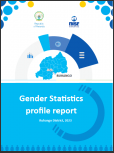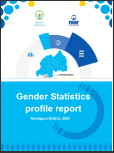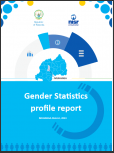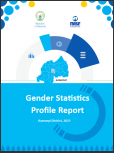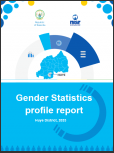National Gender Statistics Report 2024
This is the sixth edition of the National Gender Statistics Report that provides updated sex-disaggregated data in the twelve areas adopted taking into consideration the Beijing declaration and platform for action.
Gender Statistics profile report- Ruhango District, 2023
This is the second edition of the Gender Statistics District Profile Report, which provides updated sex-disaggregated data across key areas such as poverty and social protection, education, health, violence against women, the economy, decision-making, ICT and media, and the environment. These areas are classified under the National Strategy for Transformation (NST1) pillars: Economic Transformation, Social Transformation, and Transformational Governance.
Gender Statistics profile report- Nyaruguru District, 2023
This is the second edition of the Gender Statistics District Profile Report, which provides updated sex-disaggregated data across key areas such as poverty and social protection, education, health, violence against women, the economy, decision-making, ICT and media, and the environment. These areas are classified under the National Strategy for Transformation (NST1) pillars: Economic Transformation, Social Transformation, and Transformational Governance.
Gender Statistics profile report- Nyanza District, 2023
This is the second edition of the Gender Statistics District Profile Report, which provides updated sex-disaggregated data across key areas such as poverty and social protection, education, health, violence against women, the economy, decision-making, ICT and media, and the environment. These areas are classified under the National Strategy for Transformation (NST1) pillars: Economic Transformation, Social Transformation, and Transformational Governance.
Gender Statistics profile report- Nyamagabe District, 2023
This is the second edition of the Gender Statistics District Profile Report, which provides updated sex-disaggregated data across key areas such as poverty and social protection, education, health, violence against women, the economy, decision-making, ICT and media, and the environment. These areas are classified under the National Strategy for Transformation (NST1) pillars: Economic Transformation, Social Transformation, and Transformational Governance.
Gender Statistics profile report- Muhanga District, 2023
This is the second edition of the Gender Statistics District Profile Report, which provides updated sex-disaggregated data across key areas such as poverty and social protection, education, health, violence against women, the economy, decision-making, ICT and media, and the environment. These areas are classified under the National Strategy for Transformation (NST1) pillars: Economic Transformation, Social Transformation, and Transformational Governance.
Gender Statistics profile report- Kamonyi District, 2023
This is the second edition of the Gender Statistics District Profile Report, which provides updated sex-disaggregated data across key areas such as poverty and social protection, education, health, violence against women, the economy, decision-making, ICT and media, and the environment. These areas are classified under the National Strategy for Transformation (NST1) pillars: Economic Transformation, Social Transformation, and Transformational Governance.
Gender Statistics profile report- Huye District, 2023
This is the second edition of the Gender Statistics District Profile Report, which provides updated sex-disaggregated data across key areas such as poverty and social protection, education, health, violence against women, the economy, decision-making, ICT and media, and the environment. These areas are classified under the National Strategy for Transformation (NST1) pillars: Economic Transformation, Social Transformation, and Transformational Governance.
Gender Statistics profile report- Gisagara District, 2023
This is the second edition of the Gender Statistics District Profile Report, which provides updated sex-disaggregated data across key areas such as poverty and social protection, education, health, violence against women, the economy, decision-making, ICT and media, and the environment. These areas are classified under the National Strategy for Transformation (NST1) pillars: Economic Transformation, Social Transformation, and Transformational Governance.
Gender Statistics profile report- Nyarugenge District, 2023
This is the second edition of the Gender Statistics District Profile Report, which provides updated sex-disaggregated data across key areas such as poverty and social protection, education, health, violence against women, the economy, decision-making, ICT and media, and the environment. These areas are classified under the National Strategy for Transformation (NST1) pillars: Economic Transformation, Social Transformation, and Transformational Governance.


